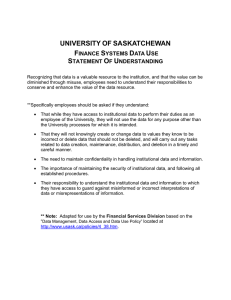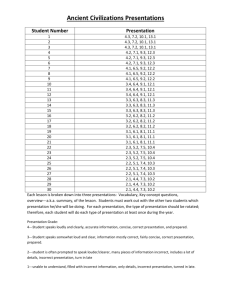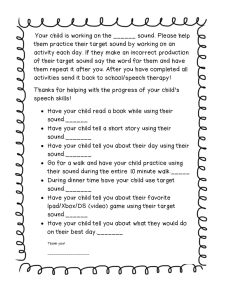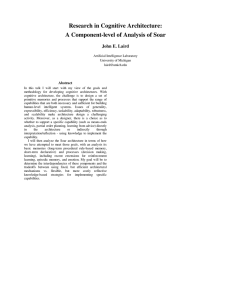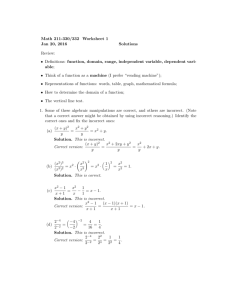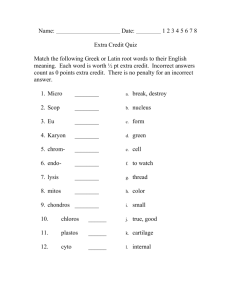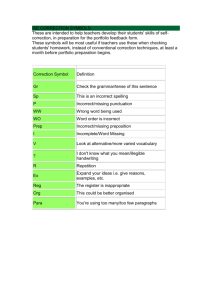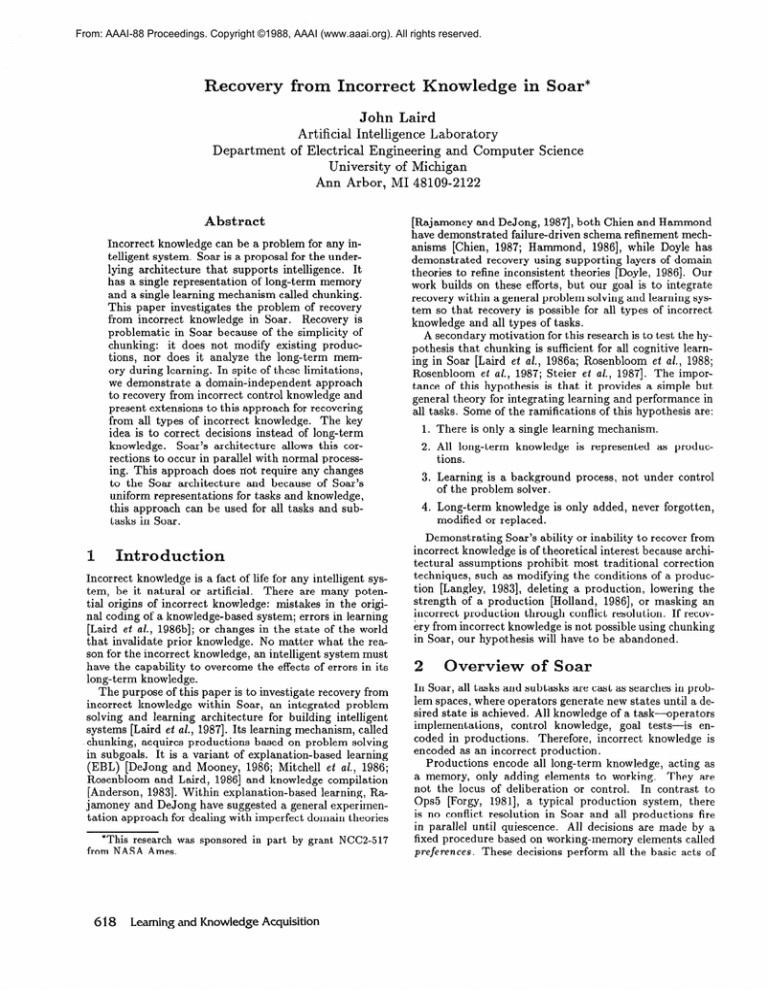
From: AAAI-88 Proceedings. Copyright ©1988, AAAI (www.aaai.org). All rights reserved.
Recovery
Department
from Incorrect
Incorrect knowledge can be a problem for any intelligent system. Soar is a proposal for the underlying architecture that supports intelligence. It
has a single representation of long-term memory
and a single learning mechanism called chunking.
This paper investigates the problem of recovery
from incorrect knowledge in Soar. Recovery is
problematic in Soar because of the simplicity of
chunking: it does not modify existing productions, nor does it analyze the long-term memory during learning. In spite of these limitations,
we demonstrate a domain-independent approach
to recovery from incorrect control knowledge and
present extensions to this approach for recovering
from all types of incorrect knowledge. The key
idea is to correct decisions instead of long-term
knowledge. Soar’s architecture allows this corrections to occur in parallel with normal processing. This approach does not require any changes
to the Soar architecture and because of Soar’s
uniform representations for tasks and knowledge,
this approach can be used for all tasks and subtasks in Soar.
Introduction
Incorrect knowledge is a fact of life for any intelligent system, be it natural or artificial.
There are many potential origins of incorrect knowledge: mistakes in the original coding of a knowledge-based system; errors in learning
[Laird et al., 1986b]; or changes in the state of the world
that invalidate prior knowledge. No matter what the reason for the incorrect knowledge, an intelligent system must
have the capability to overcome the effects of errors in its
long-term knowledge.
The purpose of this paper is to investigate recovery from
incorrect knowledge within Soar, an integrated problem
solving and learning architecture for building intelligent
systems [Laird et al., 19871. Its learning mechanism, called
chunking, acquires productions based on problem solving
in subgoals. It is a variant of explanation-based learning
(EBL) [DeJong and Mooney, 1986; Mitchell et al., 1986;
Rosenbloom and Laird, 19861 and knowledge compilation
[Anderson, 19831. Within explanation-based learning, Rajamoney and DeJong have suggested a general experimentation approach for dealing with imperfect domain theories
*This research was sponsored in part by grant NCC2-517
from NASA Ames.
618
in Soar*
John Laid
Artificial Intelligence Laboratory
of Electrical Engineering and Computer
University of Michigan
Ann Arbor, MI 48109-2122
Abstract
I
Knowledge
Learning and Knowledge Acquisition
Science
[Rajamoney and DeJong, 19871, both Chien and Hammond
have demonstrated failure-driven schema refinement mechanisms [Chien, 1987; Hammond, 19861, while Doyle has
demonstrated recovery using supporting layers of domain
theories to refine inconsistent theories [Doyle, 19861. Our
work builds on these efforts, but our goal is to integrate
recovery within a general problem solving and learning system so that recovery is possible for all types of incorrect
knowledge and all types of tasks.
A secondary motivation for this research is to test the hypothesis that chunking is sufficient for all cognitive learning in Soar [Laird et al., 1986a; Rosenbloom et al., 1988;
Rosenbloom et ad., 1987; Steier et ad., 19871. The importance of this hypothesis is that it provides a simple but
general theory for integrating learning and performance in
all tasks. Some of the ramifications of this hypothesis are:
1. There is only a single learning mechanism.
2. All long-term
tions.
knowledge is represented
3. Learning is a background
of the problem solver.
as produc-
process, not under control
4. Long-term knowledge is only added, never forgotten,
modified or replaced.
Demonstrating Soar’s ability or inability to recover from
incorrect knowledge is of theoretical interest because architectural assumptions prohibit most traditional correction
techniques, such as modifying the conditions of a production [Langley, 19831, deleting a production, lowering the
strength of a production [Holland, 19861, or masking an
incorrect production through conflict resolution. If recovery from incorrect knowledge is not possible using chunking
in Soar, our hypothesis will have to be abandoned.
a!
verview
of Soar
In Soar, all tasks and subtasks are cast as searches in problem spaces, where operators generate new states until a desired state is achieved. All knowledge of a task-operators
implementations,
control knowledge, goal tests-is
encoded in productions.
Therefore, incorrect knowledge is
encoded as an incorrect production.
Productions encode all long-term knowledge, acting as
a memory, only adding elements to working. They are
not the locus of deliberation or control. In contrast to
Ops5 [Forgy, 19811, a typical production system, there
is no conflict resolution in Soar and all productions fire
in parallel until quiescence. All decisions are made by a
fixed procedure based on working-memory elements called
preferences.
These decisions perform all the basic acts of
problem solving in a problem space: selecting the current
problem space, state and operator for a goal.
There are three classes of preferences: acceptability, necessity, and desirability.
In the acceptability class, acceptable preferences specify those objects that are candidates for a slot, while reject preferences eliminate a candidate from consideration.
Necessity preferences enforce
constraints on goal achievement by specifying either that
an object must be selected (require) or must not be selected
(prohibit) in order that the goal be achieved. The priority
of these preferences is: (prohibit, require) > reject
> accept. Therefore, an object will only be considered if
it is acceptable and not rejected and not prohibited, or if
it is required and not prohibited.
Desirability preferences also control the selection of candidates, but provide only heuristic information. In other
words, the necessity preferences encode knowledge to ensure the correctness of the problem solving, while the desirability preferences encode knowledge to improve the efficiency of the problem solving. Desirability preferences
provide either absolute (best, indifferent, worst) or relative (better, indifferent, worse) orderings of the candidates
for a slot. The desirability preferences have their own
worse)
> best > worst
precedence ordering: (better,
> indifferent.
That is, better and worse preferences are
considered first, and only those candidates not worse than
some other candidate are considered by the remaining preferences. If only a single object is preferred at the end of
this procedure, it is selected. If there are multiple objects
that are either all indifferent, all best, or all worst, a random selection is made between them. If none of the above
hold, then an impasse in problem solving arises. Impasses
will be discussed following a short example.
Consider the Missionaries and Cannibals problem. The
problem space consists of the different configurations of
three missionaries and three cannibals and a boat on the
banks of the river. The set of operators is restricted to
transporting one or two people at a time because the boat
only holds two people. The goal is achieved when all the
people have been moved from one side of the river to the
other. An additional restriction is that the cannibals can
never outnumber the missionaries on one bank of the river
because the missionaries will be eaten. In Soar, productions encode all of the necessary knowledge concerning
problem selection, operator creation, selection and implementation, state selection and goal achievement. As the
first step toward solving this problem in Soar, a production creates an acceptable preference for the Missionaries
and Cannibals problem space. Following its selection by
the decision procedure, a production fires that creates the
initial state. At this point, all relevant operator instances
for the current state are created. Assume for the moment
that additional productions exist to create preferences so
only one operator is clearly best. The decision procedure
selects that operator and relevant productions fire, creating a new state with an acceptable preference. This state is
selected and the operator slot is cleared because its current
value is no longer relevant.
In the above example, we assumed there was sufficient
knowledge to select a single operator for each state. When
the preferences for a slot do not lead to a clear choice,
an impasse in problem solving arises and a subgoal is au-
tomatically created.
An impasse may arise from a tie
(the preferences do not determine a best choice), a conflict (the preferences conflict), a rejection (all candidates
are rejected), or a no-change (no changes are suggested for
any slots). The purpose of the subgoal is to resolve the
impasse, possibly by searching for information that will
add new preferences and allow a decision to be made. In
the subgoal, search in a problem space is used as in the
original goal, allowing the full problem-solving capabilities of Soar to be used. Default problem spaces (encoded
as productions) are available to handle impasses whenever
domain-specific problem spaces are unavailable. A subgoal
terminates automatically when new preferences resolve the
impasse or lead to a new decision in a higher goal.
Chunking learns by building productions that summarize the processing in a subgoal. The action of a new production is based on a result of a subgoal, while the conditions are based on the pre-impasse working-memory elements that were tested by productions on the path to the
generation of the result. Since only the working-memory
elements relevant to the results are included, many features
of the situation are ignored. When a situation similar to
the one that gave rise to the impasse is re-encountered, the
chunk will fire, producing the result directly, completely
avoiding the impasse and its subgoal.
ncorrect
In this section we describe how recovery from incorrect
knowledge is possible in Soar without architectural modification. This will show that the necessary “hooks” already
exist in Soar for recovery to take place and that chunking is sufficient to correct errors in long-term knowledge.
This section starts with a description of incorrect knowledge in Soar and then proceeds through the five phases
of correction: detecting an incorrect decision; forcing reconsideration of the decision; reconsidering the decision;
determining the correction; and saving the correction with
chunking.
As part of this presentation,
a general,
domainindependent framework for correcting invalid control
knowledge is demonstrated.
This approach has been implemented within Soar and it will be demonstrated on the
Missionaries and Cannibals problem.
3.1
Incorrect
Knowledge
Although productions encode all knowledge in Soar, errors
only arise through incorrect decisions, that is, because the
wrong problem space, state or operator is selected. This
leads to an important observation:
a Incorrect knowledge can be corrected by modifying
the decisions in which the knowledge is used instead of
modifying the productions that encode the knowledge.
Therefore, in Soar we can shift the emphasis in recovery
from correcting long-term memory to correcting performance. If Soar learns productions that correct decisions,
it will have recovered from incorrect knowledge.
An incorrect decision is caused by an inappropriate preference. We can classify incorrect knowledge based on the
types of incorrect preferences: acceptability, necessity, and
Laird
619
desirability. Incorrect acceptable preferences correspond to
incorrect task knowledge. That is, either the wrong problem spaces, states or operators are created. For example,
if an operator is incorrectly implemented, it will produce
an acceptable preference for an inappropriate state. This
corresponds to having errors in a domain theory in EBL
[Mitchell et al., 1986; Rajamoney and DeJong, 19871. Incorrect necessity preferences correspond to incorrect goal
knowledge. Some aspect of the goal is incorrectly encoded
so that objects are either required or prohibited inappropriately.
Incorrect desirability and reject preferences correspond
to incorrect control knowledge. A simple example of incorrect control knowledge comes from the Missionaries and
Cannibals problem. An obvious bit of means-ends control
knowledge is to prefer operators that maximize progress
toward the goal and minimize movement away from the
goal. In states of Missionaries and Cannibal where the
boat is on the original side of the river, this leads to a
preference for operators that move two people, while if the
boat is on the desired side, then preference would be for
operators that move one person from the desired side back
to the original. Although usually helpful, this knowledge is
incorrect in the middle of the problem when two missionaries, two cannibals and the boat are on the desired bank.
The means-ends knowledge would prefer sending either one
missionary or one cannibal back across the river. In either
case, the resulting state would violate the rule that cannibals can not outnumber missionaries. The correct move
consists of moving one missionary and one cannibal together across the river.
To recover from this incorrect knowledge, Soar should
learn productions that can overcome the preference for
moving only one person. This is different than merely
learning from failure [Gupta, 1987; Mostow and Bhatnagar, 19871 which in Soar involves learning productions that
avoid operators leading to illegal states. If incorrect knowledge is not present, Soar will learn such productions from
look-ahead searches [Laird et al., 19841. But once the incorrect knowledge is present, Soar assumes it is correct and
makes decisions without subgoals. To do otherwise would
involve questioning every piece of knowledge and negate
the advantages of learning.
3.2
Detecting
an Incorrect
Decision
In Soar, the first step in recovering from incorrect knowledge is to detect that an incorrect decision has been made.
This simplifies the credit assignment problem by allowing
Soar to detect only incorrect behavior instead of incorrect
knowledge. In the Missionaries and Cannibals example, it
is easy to detect an incorrect decision because an illegal
state is encountered on the path to solution. In this example, general productions test for the invalid state, backtrack to the prior state and force the reconsideration of
that decision.
For other tasks, expectation failures, direct feedback
from another agent, exhaustion of resources, or other general features of the task may signal that a decision was
incorrect. In all cases, productions must detect that an
incorrect decision has been made. If the feedback is specific to a previous decision, the situation in which the error
occurred can be recreated and reconsidered. If the feed-
620
Learning
and Knowledge Acquisition
back is not decision-specific, all decisions within a goal
can be reconsidered.
Decisions likely to be correct can
be avoided using domain-specific knowledge or techniques
such as dependency-directed backtracking. General mechanisms for determining which of several decisions is in error have not been implemented except for chronological
backtracking and the reconsideration of all decisions in a
goal. Soar’s ability to exhibit a wide variety of methods
suggests that using additional techniques should not be
problematic[Laird, 1984; Laird and Newell, 19831.
3.3
Forcing Reconsideration
Once an incorrect decision is detected, it is necessary to
reconsider the decision and possibly correct it. A decision can be reconsidered by forcing an impasse so that a
subgoal arises in which the decision can be made explicitly. Impasses can be forced by adding preferences that
cause conflicts. If an acceptable preference or any desirability preferences are suspect, an impasse can be forced by
creating a new dummy object with conflicting preferences
between it and the suspected objects.
If necessity preferences are suspect, additional necessity preferences will
force an impasse. In the Missionaries and Cannibals example, an impasse is forced by creating conflicting preferences between the available operators and a dummy operator named deliberate-impasse.
3.4
Reconsidering
the Incorrect
Decision
Once the forced impasse arises, its subgoal provides a context for reconsidering the possibly incorrect decision. It is
at this point that other sources of knowledge can be accessed to verify the decision or determine an alternative
selection.
Other sources of knowledge could be experimentation in the external world [Rajamoney and DeJong,
19871, feedback from another agent, or an appeal to an underlying domain theory [Doyle, 19861 encoded as a problem
space. If any of these sources of knowledge is suspect, the
same approach can be applied recursively to correct it.
We have not implemented a general approach for obtaining the correct knowledge for task or goal errors. However, for incorrect control decisions, we have implemented
a domain-independent
approach for correcting decisions
based on look-ahead search. This approach is built upon
the selection problem space, a domain independent problem space that is used as a default whenever impasses arise
because of inadequate control knowledge.
The unextended selection space contains operators,
called evaluate-object,
which evaluate the tied or conflicting
alternatives. If an evaluation is available via a production,
it will be used. If no evaluation is directly available, an
impasse arises and a look-ahead search is performed in the
resulting subgoal to obtain an evaluation. The resulting
evaluations are compared and appropriate preferences are
created, thus resolving the impasse.
In those cases where incorrect preferences do exist, the
correct choice may not be considered because it is either
rejected or dominated by the other objects. To gather information about the rejected and dominated objects, two
new operators are added to the selection space: evuluutealternatives
and evaluate-reject.
Evaluate-alternatives,
evaluates the alternatives that are not being considered because of possibly incorrect desirability preferences, while
conflict-impasse
deliberate-impasse
State for which +
control knowledge
is incorrect
eve-C)
evaluate-object(move-M)
reject move-CC
Figure 1: Recovery from incorrect knowledge in Missionaries and Cannibals.
evaluate-reject evaluates the objects that have rejection
preferences.
Figure 1 shows a simplified trace of recovery in the Missionaries and Cannibals problem.
In this example, the
goal is to move all people to the right bank. The current state has one missionary and one cannibal on the left
bank, while the boat and the remaining people are on the
right bank. The overgeneral knowledge incorrectly prefers
moving either one missionary (move-M) or one cannibal
(move-C). An impasse is forced using deliberate-impasse.
Once in the subgoal, evaluate-alternatives
is selected. In
the resulting look-ahead search, move-C and move-M are
prohibited from being selected so that the best alternative
to them will be selected. Although this eliminates two of
the operators for the search, the three two-person operators are all available and a tie impasse arises. A look-ahead
search is performed for these in a lower selection space (not
shown) and the the winner is move-MC. Chunks learned for
this selection apply immediately to the top state, so that
move-MC is preferred over the other two person operators. Following evaluate-alternatives, moving one cannibal
(move-C) as well as moving one missionary (move-M) are
evaluated using evaluate-object.
These both return a failure evaluation because they generate illegal states in the
subgoal. These evaluations are compared to those created
for evaluate-alternatives and both move-M and move-C are
rejected so that their dominance over the other operators
is eliminated. Finally, when all of the evaluation operators
are finished, deliberate-impasse is rejected and the impasse
is resolved with move-MC being correctly selected.
3.5
Correcting
the Decision
If the object preferred by the preferences for a decision is
found to be correct, no correction is made. However, if
the preferred object is incorrect, then the decision must be
corrected. In Soar, a preference can be corrected, either at
the decision where the error occurs, or at a decision in a
higher goal, (unless the error occurs at the top goal). By
changing a higher decision, the preferences for the current
decision become irrelevant. This second case is related to
the first, because if a decision in a higher goal is changed,
then it is as if its prior decision was actually incorrect.
However, by correcting a decision in a higher goal, a lower
level decision can be avoided that is itself uncorrectable.
In either case, the only way to correct a decision is by
creating new preferences. Luckily this is sufficient.
The correction of decisions can be divided into three
cases based on the type of the incorrect preference. In the
first case, an incorrect desirability or acceptable preference
leads to an incorrect selection. It may be that an incorrect
object is made best, better than, or indifferent to the correct object. Or it may be that the correct object is made
worst or worse. In our example from the Missionaries and
Cannibals, the incorrect operator is better than the correct operator. All these cases can be corrected by rejecting
the incorrect choices. This is done in the selection space
when the evaluation created for the not-tied objects (by
evaluate-alternatives) is better than the evaluation created
for an object about to be selected (by evaluate-object).
In
this case, a reject preference is created for the incorrectly
preferred object. In our example, it is this process that
leads to the rejection of the incorrect operators. Once the
wrongly preferred object is rejected, other preferences will
lead to the selection of the correct object. (These preferences will have been learned in the evaluate-alternatives
subgoal.)
In the second case, the correct object is incorrectly rejetted or prohibited.
This case is important enough to
consider with an example. Let’s modify our example so
that instead of creating better preferences for moving one
person back across the river, all operators that move two
people are rejected. On the surface this appears to have
the same effect, but it makes recovery more difficult. How
can we select an operator that has already been rejected?
This situation is detected in the selection space when the
evaluation produced by evaluate-rejected is better than the
evaluation produced for the operator that would have been
selected if an impasse had not been forced. The appropriate response, encoded in productions, is to create a new
operator with an indirect pointer to the rejected operator.
This new operator is made better than the incorrect operator and therefore it is select. This new operator can not
be an exact copy of the rejected operator, otherwise the
production that rejected the original would also reject it.
The obvious problem is that there must be a general
way to apply these new operators, whose only structure
is an indirect pointer to another operator. The solution
is to select the new operator, fall into a subgoal when no
productions fire to apply it, and in the subgoal apply the
original, mistakenly reject operator. The original operator can be applied by forcing its selection using a require
preference which overrides the rejection. Following its selection, the productions that implement the original operator apply and create a new state that becomes the result
of the new operator. Chunking captures this processing,
and future applications of the new operator are performed
directly by the chunk.
In the third case, an incorrect object is inappropriately
required. Neither reject nor prohibit override a require
preference because it is encodes knowledge about the validity of the path toward the goal. The only general correction is to modify a higher decision. For example, if
an inappropriate operator is required for a state, a new
Laird
621
state can be created, using the indirect pointer method described above so that the offending production no longer
applies. Modifying a higher decision can also correct the
errors described earlier.
Flynn and Newell have implemented a scheme where incorrect operators are avoided by
creating a new problem space, displacing the old and then
using those elements of the old problem space that were
still valid [Newell, 19871. This approach demonstrates the
variety of approaches that are possible for recovery from
incorrect knowledge.
In summary, incorrect desirability and acceptable preferences are corrected by rejecting the incorrect alternative.
Incorrect reject and prohibit preferences are corrected by
creating acceptable preferences for new objects that have
indirect pointers to the rejected objects. Since all the preferences used in recovery are themselves correctable, any
correction can itself be corrected.
3.6
Saving
repair
the correction
as a permanent
Up to this point, we have described how Soar can correct
decisions using its problem solving, but we have ignored
the process by which a correction can be saved in longterm memory for later use. The solution is simple: once
a decision is corrected through the creation of new preferences in a subgoal, chunking learns a new production that
will fire under similar circumstances in the future, leading
to the correct choice. Most of these productions will fire in
parallel with the existing productions. However, when recovery includes creating new objects, the new productions
must test for the existence of the rejected objects that they
point to. This possibly extends the elaboration phase by
one production firing. Interestingly, repeated corrections
need not extend it further because all productions that
create rejections will fire in parallel, and a second correction need only test for the existence of the original rejected
object.
One possible issue is whether the new chunk will be applicable even when an error has not been detected and no
attempt is being made to force an impasse. In the implementation of recovery from incorrect control knowledge,
the chunks are sufficiently general because the underlying problem solving is independent of the detection of error. All operators in the selection space, such as evaluatealternatives and evaluate-rejects, are created for every tie
or conflict impasse. They are only selected when the evaluations created by evaluate-object operators are insufficient
to resolve the impasse.
The other result of the impasse is the rejecting of
deliberate-impasse.
However, the creation of the reject
preference is based on a test of exhaustion, that is, that no
more operators are available in the selection space. Tests
such as these inherently lead to overgeneralization during chunking [Laird et al., 1986b] so Soar does not create
chunks for these results.
Additional chunks are learned for the evaluations computed in the subgoal. These chunks will be available in
the future so that the evaluations are computed directly
without problem solving. One potential weakness in this
approach is that the chunk learned for evaluating alternatives may be overgeneral in that it could apply even if
additional alternatives are available. Overgenerality arises
622
Learning and Knowledge Accluisition
because there is an implicit test for exhaustion: the best of
all the alternatives was evaluated. Either no chunk should
be built or there should be a test that there are no other
alternatives available.
4
This section reports the results of using recovery from incorrect knowledge. In Missionaries and Cannibals, without the incorrect knowledge or chunking, the problem is
solved in between 178 and 198 decisions, depending on the
search. Following learning, the minimum is 22 decisions-a
straight line path. Soar learns control knowledge to avoid
operators that produce illegal states, as well as learning to
select operators that are on the path to solution.
Adding the incorrect control knowledge, but not the recovery knowledge, decreases the number of operators considered at each state, thereby decreasing the search to between 124 and 149 decisions, but an illegal state is always selected at the top-level. After learning, the minimum number of decisions is 25 because the illegal state
is created, selected and then rejected, By introducing the
recovery knowledge, search before learning is between 159
and 179 decisions. This is less than without the incorrect
knowledge, but more than without the recovery code. The
important point is that following learning, the minimum
is once again 22 decisions. Another test of recovery is to
use it after learning has been applied to the incorrect control knowledge. In this case, the problem solving goes up
from 25 to 54 decisions, however, after learning the problem solving goes back down to 22. Such a reduction was
not possible without recovery.
The productions for controlling recovery from incorrect control knowledge are completely task-independent
and they have been used for other simple tasks such as
the Eight Puzzle and multi-column subtraction.
In the
Eight Puzzle, we have added a production that incorrectly
prefers to move tiles out of their desired position. This
makes it impossible to solve the problem without recovery.
In multi-column subtraction, the system incorrectly skips
columns as a result of an overgeneral chunk. If it receives
negative feedback when it has skipped a column, it backs
up and correctly finish the problem.
Table 1 is a summary of example results for these tasks
as well as Missionaries and Cannibals. For the Eight Puzzle, it solved a relatively simple problem that requires 12
decisions. For subtraction, the system solves 44-33. The
column following the task name contains the number of
decisions required to solve the problem if incorrect knowledge is included but the recovery knowledge is not. The
next column shows the number of decisions required when
the recovery knowledge is added. This usually increases
the total time required to solve the problem, however it
leads to improved performance after recovery as shown in
the final column.
5
conclusion
We have demonstrated an alternative approach to recovery
from incorrect knowledge that does not require deletions
or corrections to long-term memory. Instead of modifying
long-term memory, the corrections are made during the
decisions that arise during the normal course of problem
Task
I
Missionaries
Subtraction
Eight Puzzle
-
Table 1:
tasks.
Without
Recoverv
With
Recoverv
After
Recoverv
25
13
00
54
21
45
22
10
12
I
Results
I
I
pages 593-624. Morgan Kaufmann Publishers, Inc., Los
Altos, CA, 1986.
[Laird and Newell, 19831 J. E. Laird and A. Newell. A
universal weak method: Summary of results. In Proceedings of IJCAI-83,
Los Altos, CA, 1983. Kaufman.
J
of using recovery knowledge on three
[Laird et al., 19841 J. E. Laird, P. S. Rosenbloom, and
A. Newell. Towards chunking as a general learning
mechanism. In Proceedings
of AAAI-84.
American Association for Artificial Intelligence, 1984.
[Laird et al., 1986a] J. E. Laird, P. S. Rosenbloom, and
A. Newell. Chunking in Soar: The anatomy of a general
learning mechanism. Machine Learning, l:ll-46,
1986.
solving. The corrections are first determined by problem
solving, and then saved as productions by chunking so that
the corrections will be available in the future, even before
an error in behavior is detected. In addition to demonstrating the feasibility of this approach, we have presented
a domain-independent implementation that corrects errors
in control knowledge. Within this framework, future research should concentrate on expanding the class of situations in which incorrect decisions can be detected and
expanding the sources of knowledge used to verify a decision .
[Laird et al., 19871 J. E. Laird, A. Newell, and P. S. Rosenbloom. Soar: An architecture for general intelligence.
Artificial Intelligence,
33(3), 1987.
Acknowledgments
[Laird, 19841 J. E. Laird. Universal SubgoaEing.
sis, Carnegie-Mellon University, 1984.
Many of the ideas in the paper originated in discussions
with Allen Newell, Rex Flynn, Paul Rosenbloom and Olin
Shivers. Thanks to Pat Langley and Mark Wiesmeyer for
comments on an earlier draft of this paper, and Rob McCarl for his Soar implementations of multi-column subtraction.
The Architecture
of
[Anderson, 19831 J. R. Anderson.
Cognition.
Harvard University Press, Cambridge, MA,
1983.
[Chien, 19871 S. A. Chien. Extending explanation-based
learning: Failure-driven schema refinement.
In Proceedings
of Third
IEEE
Conference
on AI Applications,
1987.
[DeJong and Mooney, 19861 G. DeJong and R. Mooney.
Explanation-based
learning: An alternative view. Machine Learning,
1(2):145-176,
1986.
[Doyle, 19861 R. Doyle. C onstructing and refining causal
explanations from an inconsistent domain theory. In
Proceedings
of AAAI-86.
Morgan Kaufmann, 1986.
[Forgy, 19811 C. L. Forgy. Ops5 user’s manual. Technical
report, Computer Science Department, Carnegie-Mellon
University, July 1981.
[Gupta, 19871 A. Gupta. Explanation-based failure recovery. In Proceedings
of AAAI-87,
pages 606-610, Seattle,
1987.
[Hammond, 19861 K. Hammond. Learning to anticipate
and avoid planning failures through the explanation of
failures. In Proceedings
of AAAI-86.
American Association for Artificial Intelligence, 1986.
[Holland, 19861 J. H. Holland. Escaping brittleness: The
possibilities of general-purpose learning algorithms applied to parallel rule-based systems. In Machine Learning:
An
Artificial
Intelligence
Approach,
Volume
[Laird et al., 1986b] J. E. Laird, P. S. Rosenbloom, and
A. Newell. Overgeneralization during knowledge compilation in Soar. In Proceedings
of the Workshop
on
Knowledge
Compilation,
Otter Crest, OR, 1986. Oregon
State University, Oregon State University.
[Langley, 19831 P. Langley.
Learning
of IJCAI-83,
heuristics. In Proceedings
PhD the-
effective
1983.
search
[Mitchell et al., 19861 T. M. Mitchell, R. M. Keller, and
S. T. Kedar-Cabelli.
Explanation-based generalization:
A unifying view. Machine Learning, 1, 1986.
[Mostow and Bhatnagar, 19871 J. Mostow and N. Bhatnagar. Failsafe - a floor planner that uses EBG to learn
of IJCAI-87,
Milano,
from its failures. In Proceedings
Italy, 1987. IJCAI.
[Newell, 19871 A. Newell. Unified theories of cognition:
1987 William James lectures. Available on videocassette
from Harvard Psychology Department, 1987.
[Rajamoney and DeJong, 19871 S. Rajamoney and G. DeJong. The classification, detection and handling of imof IJCAI-87,
perfect theory problems. In Proceedings
pages 205-207, Milano, Italy, 1987. Morgan Kaufmann.
[Rosenbloom and Laird, 19861 P. S. Rosenbloom and J. E.
Laird. Mapping explanation-based generalization onto
Soar.
In Proceedings
of AAAI-86,
Philadelphia, PA,
1986. American Association for Artificial Intelligence.
[Rosenbloom et al., 19871 P. S. Rosenbloom, J. E. Laird,
and A. Newell. Knowledge-level learning in Soar. In
Proceedings
of AAAI-87.
American Association for Artificial Intelligence, American Association for Artificial
Intelligence, 1987.
[Rosenbloom et al., 19881 P. S. Rosenbloom, J. E. Laird,
and A. Newell. The chunking of skill and knowledge. In
Working Models of Human Perception.
Academic Press,
London, 1988. In press.
[Steier et al., 19871 D. Steier, J. E. Laird, A. Newell, P. S.
Rosenbloom, et al. Varieties of learning in Soar: 1987.
In P. Langley, editor, Proceedings of the Fourth International Workshop on Machine
Learning.
Kluwer, 1987.
II,
Laird
623

